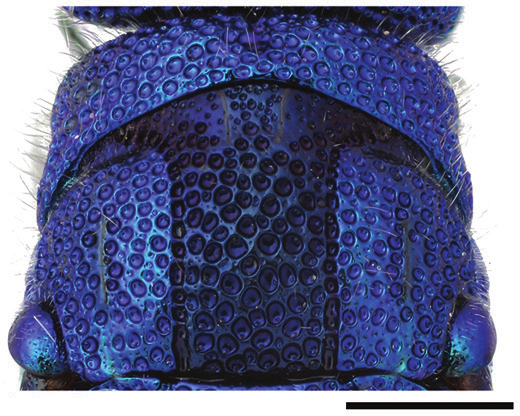Chrysis indigotea
- Innhold
- Diagnosis
- Distribution
- Biology
Diagnosis
Figure 82
T3, dorsal view: C. indigotea ♂. Scale 1 mm.
Figure 156
Pronotum and mesoscutum, dorsal view: C. indigotea ♀. Scale 1 mm.
Length 6–9 mm.
The body is entirely dark blue or violet with greenish reflections. Usually the male is more greenish or lighter blue than the female. The species can be confused with C. iris, but the mesoscutum is medially distinctly darker than laterally (Fig. 156), the punctation of the mesoscutum is denser and the ovipositor is broader (as in Fig. 91). Also the black spots of S2 are smaller and the apical teeth of T3 are more sharply produced (Fig. 82).
Distribution
Sweden. Very rare. Only one specimen is known from Östergötland, collected probably in the late 1840s or early 1850s (leg. A.G. Dahlbom).
West Palearctic: central and southern Europe, northern Africa, Asia Minor (Linsenmaier 1959).
Be aware that the records present in the GBIF map may be misleading for some countries due to unrevised data sets or missing information.
GBIF Taxon: Chrysis indigotea Dufour & Perris, 1840Biology
Habitat: forest margins, clearings and gardens with sun-exposed dead wood (Trautmann 1927, 1930, Heinrich 1964, Brechtel 1986, Rosa 2006). Adults occasionally visit flowers of Apiaceae (Trautmann 1927, Linsenmaier 1997, Rosa 2006).
Flight period: June to August.
Host: possibly Gymnomerus laevipes (Shuckard) (Vespidae) and/or Ectemnius rubicola (Dufour and Perris) (Crabronidae) (Dufour and Perris 1840).

